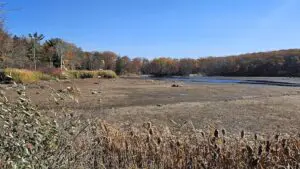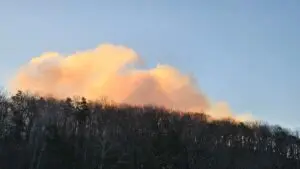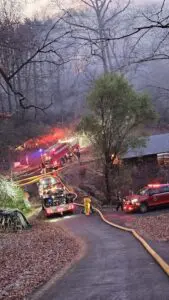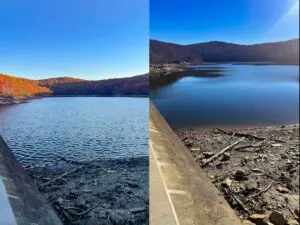Record-high temperatures meet record-low rainfall
The 0.2 inches of rain that fell on Philipstown and Beacon on Sunday (Nov. 10) brought about that much relief to the Hudson Valley, which continues to grapple with the one-two punch of widespread drought and wildfires.

Forest rangers are monitoring 12 wildfires across the state. Ten are in the Hudson Valley, including the Old Pawling Fire in Dover and the Golf Ridge Fire in Kent. Both of those fires are contained. The only fire not contained is the Jennings Creek Fire, which straddles the New York/New Jersey border. As of Thursday morning (Nov. 14), the fire was 41 percent contained and down to 4,383 acres from its previous size of 5,000 acres.
From 2007 to 2023, New York averaged around 1,400 acres of wildfire damage each year. The Jennings Creek Fire is the largest fire in the state since 2008.
“This has been a challenge for us, because normally, starting in September, you see a lot more rainfall,” Gov. Kathy Hochul said in a statement on Tuesday. “The ground would be saturated, and something like this would not have taken hold.”
The dry conditions have fueled the flames, particularly oak leaves, grasses, blueberry bushes and mountain laurel, according to the state Department of Environmental Conservation.


Last month was both the second-driest and the second-hottest October in the contiguous U.S. in 130 years of recordkeeping, with many eastern cities, including Newark, Trenton and Philadelphia, receiving only trace amounts of rain. New York City’s rainfall in October totaled 0.1 inches; Beacon got 0.29 inches. Every state except Alaska is under drought restrictions.
Cold Spring Mayor Kathleen Foley said on Nov. 13 that the village’s reservoirs were “holding steady” at 57.29 percent, and credited the public’s conservation efforts with slowing the rate of decrease. Cooler recent temperatures, thanks to a Canadian air mass, have also led to less evaporation.
In Beacon, City Administrator Chris White said that the city’s two main reservoirs — the Cargill reservoir and the reservoir atop Mount Beacon — were at 60 percent capacity. However, the city’s third reservoir, the Melzingah, is offline this time of year and is nearly full. “We’re still in good shape for now, although we could use rain badly,” he said.

New York State’s climate projections, released earlier this year, warned that coming years will have wetter summers and more droughts, a finding that would seem to contradict itself.
“Those high temperatures are evaporating more water from plants and the soil,” explained Amanda Stevens, the report’s editor. “So there’s more moisture going into the atmosphere, and the atmosphere can hold more of that moisture. When it rains, we get a lot of it coming down at once. In between, we’ll potentially get these periods of drought; because the atmosphere is holding more moisture, it doesn’t have to rain as often.”
Wetter summers can also lead to a lusher and more widespread undergrowth spreading throughout the forest, which becomes fuel for wildfires in dry, windy autumns. Joseph Pries, the state forest ranger for Dutchess and Putnam counties, told The Current earlier this year that higher temperatures were leading to longer and longer fire seasons.
“It used to be April to October, but now we’re seeing fires in November and December and February and March,” he said.
A burn ban remains in effect across New York State until Nov. 30, and residents are encouraged to remove leaves and other debris from around their homes. The DEC noted that although wildfires do occur naturally from lightning, most of them are the result of human activity.
For more on the threat in the Highlands, see our series, Wildfires: What Are the Risks?, at highlandscurrent.org/wildfires.


Thanks to Brian PJ Cronin and The Current for the excellent report on our wildfire season, and especially for the long view regarding causes and impacts. Shortly after I read the story, I heard a National Public Radio news report regarding the Jennings Creek Fire in Orange County that indicated 165 homes in Warwick had been voluntarily evacuated. The danger and high costs of wildfires are no longer a West Coast-only phenomenon. We in the Northeast can add wildfires to the costs of worsening climate impacts such as drought and flooding.
As Brian reported, the cause of these additional, larger and longer-burning fires is the changing climate. The single greatest solution to climate change is to eliminate the burning of fossil fuels in every area of our society, as quickly as possible. Our governments at every level and private corporations must do more to accelerate this effort. We must each do our part to eliminate fossil fuels from our homes, vehicles and lifestyles.
Fortunately for many of us in the U.S., it’s an investment, rather than a sacrifice, that happens to pay personal as well as global dividends. I encourage everyone to learn what you can do at the household level by visiting sustainableputnam.org/7-steps.
Montuori is the executive director of Sustainable Putnam.